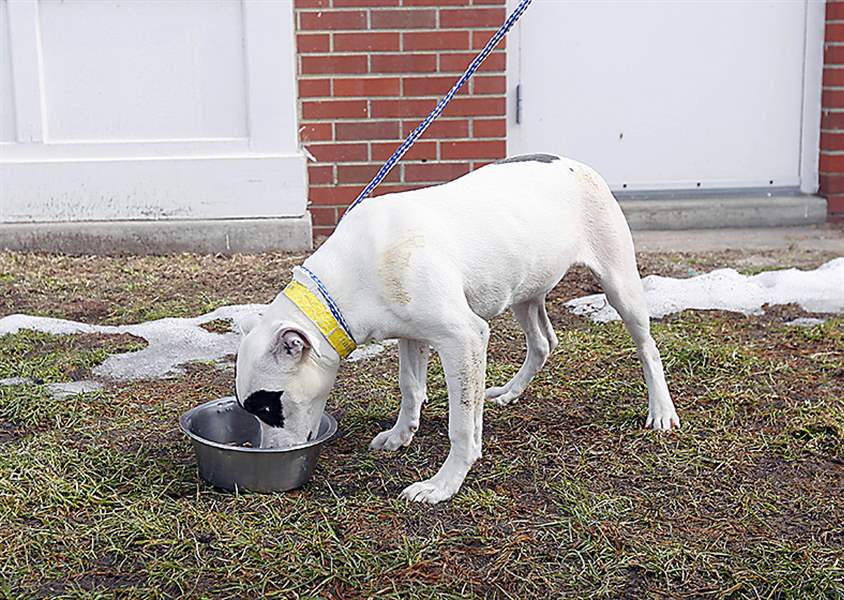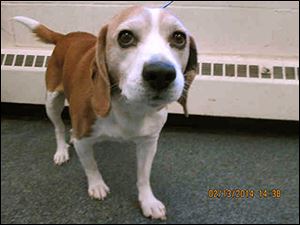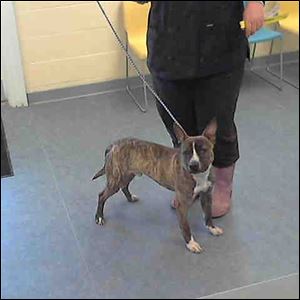
Food guarder killed in error; 2 dogs put in pilot program
Food guarder killed in error; 2 dogs put in pilot program
3/12/2014
Bella, a female ‘pit-bull’ mix, above, eats from her bowl outside Lucas County Canine Care & Control. Bella is now in the center’s free-feeding program.
THE BLADE/AMY E. VOIGT
Buy This Image

Bella, a female ‘pit-bull’ mix, above, eats from her bowl outside Lucas County Canine Care & Control. Bella is now in the center’s free-feeding program.
Two dogs that have qualified for the Lucas County Canine Care & Control’s pilot free-feeding program for food guarders since it was created last week have been given a second chance, but a third dog was killed mistakenly.
County commissioners approved creating a 60-day pilot program during which dogs of any breed who freeze or growl over a food bowl during a behavior evaluation would be given constant access to large amounts of food, a technique that experts said corrects the behavior in most cases. Additionally, “pit bull”-type dogs who exhibit concerning behaviors such as gulping food and refusing to lift their heads from the bowl are also part of the program.
Such behavior generally would have been a death sentence for the dogs before the program was created.
“We’re doing the program and we’re plugging along,” shelter Director Julie Lyle said. “There aren’t results to look at yet.”
Dogs who bite a fake hand to protect their food are not a part of the pilot program and are killed. Dogs who are a part of the program will not be adopted out at the county shelter and must be transferred to another rescue in order to be saved.
The shelter made a serious error with the program last week. The Blade found that staff killed a brindle and white male “pit bull” mix on March 7 that should have been put into the free-feeding program. The dog froze over a food bowl but did not bite, during his behavior evaluation March 6, which qualified him for the program.
“It was a staff error,” Ms. Lyle said. “It got missed, and we’re dealing with it internally.”

A 5-year-old beagle mix, at right, is the first dog to go to the Prisoners Helping Dogs program to receive behavior modification to stop food-guarding behavior.
Because of the mistake, Ms. Lyle created a “Euthanasia Checklist” that is now being completed before every dog slated for euthanasia is killed. It asks a series of questions regarding the dog’s status, which Ms. Lyle said are designed to prevent any similar mistake from happening again.
“Two people have to sign off on it, with at least one person in management,” she said.
In addition to the mistake, a dog was killed March 10 that froze over a food bowl, which would have qualified the tan female “pit bull” for the program. But Ms. Lyle said this dog also had a broken leg, which prevented the shelter from holding it for an extended period of time in the free-feeding program.
When a rescue group could not be found to take the dog and care for its injury, it was killed.
Ms. Lyle said dogs that qualify for the program are free-fed for a week, during which they are offered for transfer to area rescue groups. They are reassessed after a week and if they show improvement, they are given a second week in the free-feeding program to find a transfer.
If there is no improvement after a week or if another rescue organization does not take a dog by the end of the second week, the dog will be killed.
“Generally, no dog gets more than a week on the transfer list unless there is someone actively trying to find a way to take it,” Ms. Lyle said. “These [food-guarding] dogs theoretically are getting two weeks.”
One of the two dogs that made it into the program thus far is a 5-year-old tan and white beagle mix who came to the shelter as a stray in early February and froze over a food bowl during his behavior evaluation. The dog, first dubbed Anderson and renamed Hunter, was sent Tuesday to the Prisoners Helping Dogs training program at Toledo Correctional Institution, where inmates teach dogs manners and basic obedience over several weeks.
“We have a behavior expert working with this dog [and his inmate trainer] for food guarding,” Ms. Lyle said.
Hunter is the first food guarder to be sent there for behavior modification training after the program was expanded last week to allow them.

This stray ‘pit-bull’ mix was euthanized by mistake, said shelter director Julie Lyle. She said she has taken steps to ensure the mistake does not occr again.
The second dog, a 6-month-old white and black female “pit bull” mix named Bella, entered the shelter Feb. 26 as a stray. Her behavior evaluation showed she gulped her food and did not lift her head from the bowl. Bella has been free-fed since last Wednesday, the first day of the pilot program.
As part of the program, the county shelter is waiving the $50 fee rescues would otherwise pay to take a dog if that dog is a food guarder. The county is also providing an additional $100 per-dog incentive for rescues who take food guarders.
Ms. Lyle said a rescue group is considering taking Bella, though the organization hasn’t made a final decision about her.
Two of the shelter’s transfer partners said the new programs for food guarders and the incentives are a good idea.
“It may bring in new people who want to help out, and it gives those who have already been helping some help with their costs” for rehabilitating food guarders, said Gary Willoughby, executive director of the Toledo Area Humane Society.
Nikki Morey, executive director of Planned Pethood, said the ultimate success or failure of the program remains to be seen and depends on rescues having space to take food guarders. Still, it is a positive change.
“It will be wonderful to be able to save an animal that otherwise would have been put to sleep,” she said.
Three dogs — a German shepherd mix, an American bulldog, and a “pit bull” — that tried to bite over a food bowl were killed March 5 when the program began. Two more dogs who bit to protect their food bowl, a Great Dane and a Rottweiler, were killed March 9 and 10, respectively.
Contact Alexandra Mester: amester@theblade.com, 419-724-6066, or on Twitter @AlexMesterBlade.